Book contents
- Frontmatter
- Contents
- Foreword by Ernest Naylor
- Preface: ‘A fragment of a possible world’
- Acknowledgements
- 1 Introduction
- 2 Growth unlimited: blooms, swarms and plagues
- 3 Self-regulating systems: from machines to humans
- 4 The wealth of homeodynamic responses
- 5 A cybernetic approach to growth analysis
- 6 A control mechanism for Maia
- 7 The three levels of adaptation
- 8 Population growth and its control
- 9 Hierarchy: a controlled harmony
- 10 History of hormesis and links to homeopathy
- 11 Maian mechanisms for hormesis and catch-up growth
- 12 Cellular growth control and cancer
- 13 Human overpopulation
- 14 Our finite Earth
- 15 The Maia hypothesis and anagenesis
- Glossary
- Further reading
- References
- Index
12 - Cellular growth control and cancer
Published online by Cambridge University Press: 10 January 2011
- Frontmatter
- Contents
- Foreword by Ernest Naylor
- Preface: ‘A fragment of a possible world’
- Acknowledgements
- 1 Introduction
- 2 Growth unlimited: blooms, swarms and plagues
- 3 Self-regulating systems: from machines to humans
- 4 The wealth of homeodynamic responses
- 5 A cybernetic approach to growth analysis
- 6 A control mechanism for Maia
- 7 The three levels of adaptation
- 8 Population growth and its control
- 9 Hierarchy: a controlled harmony
- 10 History of hormesis and links to homeopathy
- 11 Maian mechanisms for hormesis and catch-up growth
- 12 Cellular growth control and cancer
- 13 Human overpopulation
- 14 Our finite Earth
- 15 The Maia hypothesis and anagenesis
- Glossary
- Further reading
- References
- Index
Summary
It is a property of life to grow and multiply, but when cells co-operate in the construction of a complex organism, their growth must be regulated in the interest of the whole organism.
Albert Szent-GyörgyiCancer is not merely a medical problem: it is a biological phenomenon.
Julian HuxleyIt will be time to talk about causes [of cancer] when mechanisms have been worked out.
Nature Editorial (1981)CANCER: FROM NORMALITY TO CYBERNETIC FAILURE
It was in 1981 that John Cairns, the eminent British physician and molecular biologist, recognised that the study of cancer was not advancing. In an influential review article, The origin of human cancers, he made a plea for a return to basic biology. At the time there seemed to be no promising ideas pointing to a breakthrough.
There are approximately 80 trillion cells in the human body, about 2 trillion at birth and 40 times that at maturity. It is estimated that 2% of all cells die each day, and as the total number in adulthood remains fairly constant, an equivalent number of cells must be created. This means that a large number of cells, of the order of 16010, are turned over daily. Billions of cells are lost each day due to wear and tear, so replacement must proceed at a similar rate.
Cell growth accelerates to close a wound, and stops once healed over. Self-regulating mechanisms are required for each tissue and organ, to ensure that each continues to meet its particular purpose.
- Type
- Chapter
- Information
- A Cybernetic View of Biological GrowthThe Maia Hypothesis, pp. 292 - 326Publisher: Cambridge University PressPrint publication year: 2010



